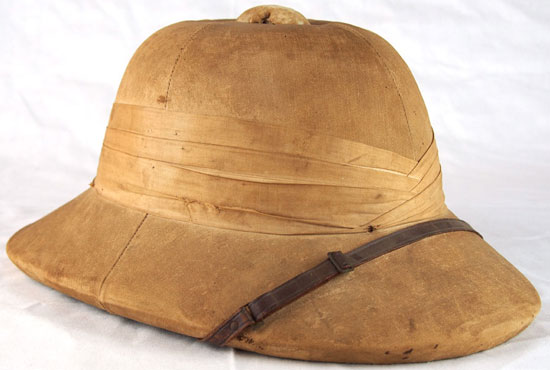
A pith helmet in the capital of the British Empire might not seem that odd at all. A helmet made of pith with a London maker/retailer stamp does seem a bit more odd – especially when one considers that the majority of helmets produced in Great Britain were in fact made of cork. As we’ve noted cork and pith are two distinct materials, and English hatters opted for cork, which came from nearby Portugal; while we have found that Indian hatters worked with sola pith, which was more common in the subcontinent.
There are no doubt countless exceptions to the rule, and both Roland Gruschka and I have discovered Wolseley helmets that seem to have been made in India. This is interesting as the Wolseley was a helmet largely produced in cork. Shortages of the material in World War I resulted in helmets with straw bodies as noted by two examples in my colleague Stuart Bates’ collection, and during World War II shortages of cork resulted in helmets being produced out of pressed felt.
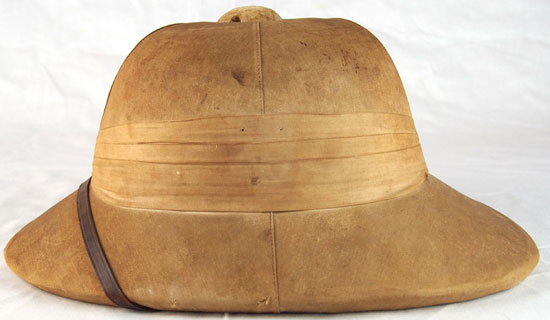
Made of pith this helmet has the basic shape of the Wolseley (Author’s Collection)
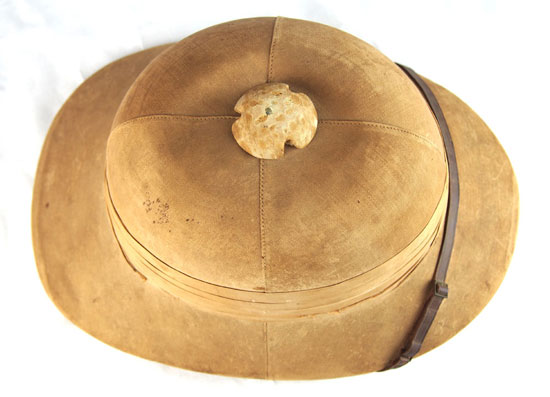
The dome of the helmet has been crushed in slight – an all too common problem with helmets made of sola pith (Author’s Collection)
Recently another interesting helmet came “out of the woodwork” and it is fascinating because it closely resembles the Wolseley helmet pattern in shape and even size – apart from being slightly thicker overall due to the use of pith instead of cork. The helmet has the appearance of an Indian made helmet, and it likely dates from the pre-World War I era.
Inside the dome under the faux ventilator cap is a label for “Townend’s London,” and it also reads, “Made in England.” Townend’s of course is a noted hatter, which made some unique sun helmets. The fact that this helmet is made of sola pith and was – at least according to the label – made in England is a minor mystery, if only for the fact that other examples have not shown up.
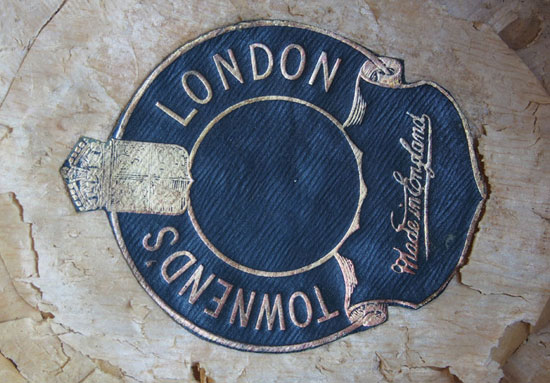
The label inside the helmet indicates that this helmet was “Made in England” (Author’s Collection)
This helmet was purchased from an antique dealer in California and there is no other chain of custody so how it arrived in the Western United States is a mystery that will never likely be resolved.
One final item worth noting is that this helmet likely had German Afrika Korps shields on each side. When these were put on the helmet and how long they were there isn’t clear but there is the slight outline of the shields and three holes that would correspond with the lugs on the shields.
As we’ve noted it is all too common for badges and insignia to be added to a helmet at some point long after its use by its original owner. However, the outline of the shields does suggest plates for one this helmet for some time – so was this helmet captured in Crete or North Africa and German used? That is the final mystery that sadly can’t be answered.
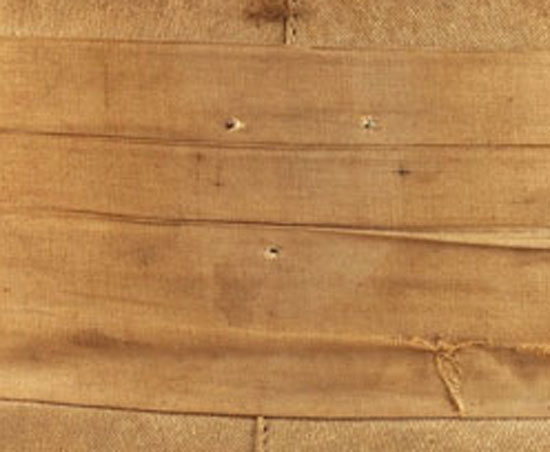
A close up of the side of the helmet shows the three small pin-size holes that were likely for the prongs on a German Afrika Korps shield. If you look carefully you can see that the fabric is slightly lighter near the holes indicating the presence of such a badge (Author’s Collection)
All told this is a fascinating helmet with likely an interesting history, but sadly it is one that likely has been lost to the ages!

Peter,
Actual manufacture of sola pith helmets in London remains a grey area. Certainly, helmets were made up in the1860s, from bulk sola pith exported out from India, we have proof for this, but practice later is more uncertain. The Thomas Townend helmet shown on Page 67 of Jaunty Hat Volume 1 is early, perhaps 1870s. Later, when steamship transport had lowered costs, I think it was likely commercial practice for London makers to import finished sola pith shells made by Indian hatters, and to finish them off in London. I have seen relatively few sola pith helmets named to London makers, but they were there. Certainly, as you say, felt and cork were more regular English trade materials. There is relatively little in the English press to prove the point, but mores of the times would not have had English hat makers alluding to their hat bodies at retail made in India, trimmed in London. Manufacture would have been represented as wholly London made.
Chris Mills.
Hello Mr. Mills,
I have what I believe is a Thomas Townsend pith helmet that belonged to my great grandfather. May I send you photos and get your opinion on it?